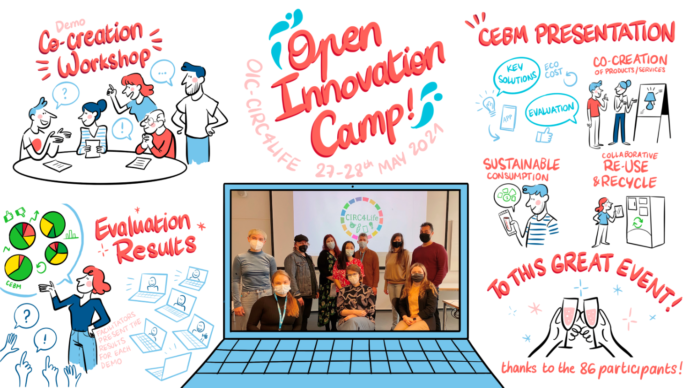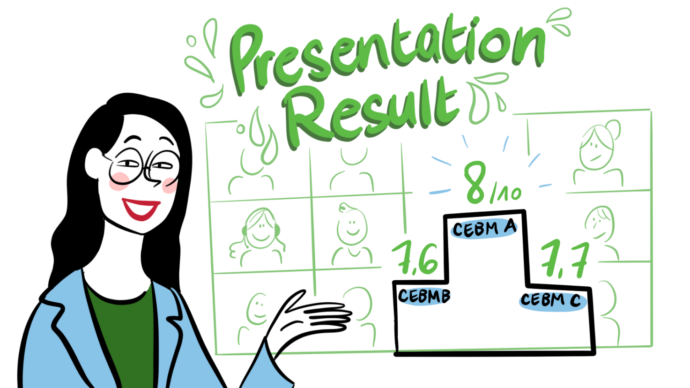A multidisciplinary group of Laurea UAS Master’s degree students facilitated the CIRC4Life Virtual Open Innovation Camp in May 2021. The work included planning and facilitating the multiple simultaneous co-creation sessions and the Welcome Event for the large-scale EU-funded circular economy innovation camp. Seventy circular economy experts from around the World, including representatives of seventeen consortium partners across eight EU countries, participated in the camp. In this article Satu Lähdeoja, a Master’s degree student in Service Design, describes the experience.
 Illustration by Cartoonbase Ltd.
Illustration by Cartoonbase Ltd.
CIRC4Life is an international innovation project, that aims to develop and implement a circular economy approach for sustainable products and services and consists of seventeen consortium partners across eight European countries. The three-year project is supported by the H2020 Circular Economy Programme by the European Commission and is coming to an end on autumn 2021.
The CIRC4Life project has developed three innovative Circular Economy Business Models (CEBMs): 1) Co-creation of Products and Services, 2) Sustainable Consumption and 3) Collaborative Recycling and Re-use. These three Circular Economy Business Models have been further demonstrated by some of the consortium partners in four different industrial areas, which are industrial and domestic LED Lighting Products, Meat Supply Chain, Computer Tablets and Vegetable Micro-farming.
In May 2021, Laurea’s team organized the second CIRC4Life Open Innovation Camp (Santonen et al 2019) as a virtual event, with the aim to disseminate, validate and evaluate the results of the project. The Camp was successfully planned and facilitated in a co-operation with multidisciplinary group of Laurea Master’s students, who decided to include the event to their study plans as project studies.
Master’s degree student as a camp facilitator
As a Master’s degree student in Laurea, I took part in May in facilitating the camp. In this article, I will reflect what happened and what I learnt.
According to the original plan, the Open Innovation Camp was designated to take place in Spain as a physical event, but due to Covid-19 pandemic, the event got transformed into Virtual Open Innovation Camp. This meant we swapped travel tickets, hotel bookings, lecture rooms, papers, pens and coffee chats for virtual platforms, headphones, mic tests, chat questions, comment boxes, breakout room discussions and digital votings. Instead of seventy experts travelling to Spain, they all stayed put in their own towns across the World and joined together via their computers, whilst sitting in their own home offices, farms, factories or gardens.
Training for the camp
There was a group of us, eight students, who would facilitate the two-day Virtual Open Innovation Camp from Laurea Tikkurila campus. We were a variety of nationalities, studying Master’s degrees either in Service Design, Leading Transformational Change or Service Innovation and Design at Laurea. The training involved planning together the schedule for the camp, the specific co-creation sessions and the tasks and activities for the sessions. We practised using Howspace, which is a virtual collaboration tool and a useful platform for co-creative working for groups. We read books and articles about facilitation and participatory decision-making and built a good knowledge base before starting the actual planning for the camp.
Planning the camp
We had an ideation session for the Welcome Event. I volunteered to plan and run the Welcome Event with another student. Out of the co-created ideas we collated, structured, scheduled and scripted the event, built the Howspace page and eventually hosted the Welcome Event.
The Laurea logo in my Zoom background picture flickers so I quickly restart my laptop, double-check that the pages of my script are in a correct order, adjust the headphones, turn up the volume, take a sip of water, turn to look left to check how the other facilitator is doing on the other side of the room. We smile. I look back at the screen, unmute my mic and start: “It’s a great pleasure to warmly welcome you all to the Welcome Event of the CIRC4Life Virtual Open Innovation Camp 2021”. I can see over seventy circular economy experts, all in small boxes on my screen.
We co-created the camp with the project team. We got to engage in the process in a very practical way. We started the journey as a disorderly bunch of busy bees hurling around, and grew slowly into a tightly working, effective, supportive and accomplished collaboration. Putting a random set of people together and asking them to make decisions can be a rocky road. We all had different views on how the project should be run, the activities organised, the training led, the camp participants engaged and the responsibilities divided. The co-creative process represented a group decision-making process in miniature. It required us to go through all the group decision-making stages. There were, for sure, times, when I hoped someone would just tell us what to do rather than us co-creating the process. Afterwards, I am happy no-one did that as it would have ruined the process for us to create a common understanding, which eventually enabled us to fly a lot higher.
Group decision-making
The planning process followed the group decision-making theory by Sam Kaner (2014, 18). We started with a new topic in a fantastic divergent thinking zone with heaps of ideas and suggestions flying around regarding what the sessions could include. We stumbled on some of the safe familiar options and opinions at first but managed to get past them and broadened the perspective. There was a real temptation just to stop at the first decision point and settle for the obvious lazy solution. But we did not since we wanted something more than the easy option. We continued with the process, eventually hitting the Groan Zone.
According to Kaner (2014, 21), the Groan Zone is a struggle that appears after the divergent thinking and before reaching the convergent thinking zone. It is the uncomfortable time, when everything feels confusing and frustrating, but at the same time it is the necessary moment, when the foundation for a fruitful collaboration is built. And we got through it! Struggling through the unknown led us into trust and a common ground that enabled a meaningful co-operation during the camp.
Facilitating the camp
The aim of the Virtual Open Innovation Camp 2021 was to disseminate, validate and evaluate the results of the project, by using co-creative methods. According to Kaner (2014, 29), full participation, mutual understanding, inclusive solutions and shared responsibility of the participants lead into stronger individuals, stronger groups and stronger agreements. These benefits of participatory values speak for themselves to support the use of co-creation as the method for the evaluation of the CIRC4Life project during the camp.
We facilitated the Virtual Open Innovation Camp in small teams, changing the line-up and the roles as the camp proceeded. We assigned three different roles for each session. One of us was the main facilitator explaining the tasks, facilitating the conversation, summarizing discussions and presenting voting results. Another monitored the chat, answered the participants’ questions and helped with technical issues. The third one operated Howspace hiding and unhiding widgets as planned and transferred photos of the voting results into the necessary slots. We had a script and a schedule to follow.
 Illustration by Cartoonbase Ltd.
Illustration by Cartoonbase Ltd.
According to Schwarz (2017, 59) the mutual learning approach is the greatest asset for a facilitator. The mindset includes five core values, which are transparency, curiosity, accountability, compassion and informed choice. These are values we tried to nurture by asking genuine questions, using specific examples, explaining the intent and reasoning, and encouraging participants to share relevant information. As the camp proceeded, I also tried to follow the three tips for a fearless facilitator by Cyndi Maxey, which are to remember that my goal is to be of value to the participants, I help them most when my focus is on them with attentiveness and interest, and that I should aim to enable all participants to participate (Maxey et al. 2013, 8-15). At times I felt I succeeded.
Conclusions
Project studies, such as CIRC4Life Open Innovation Camp, can be considered an excellent opportunity for the students for tailoring their study experiences and contents. Currently, there are 80 externally funded RDI projects actively running at Laurea, providing interesting and topical learning opportunities for both Degree and Master’s Degree students.
I saw the announcement for the facilitators earlier in the Spring and thought participating could be useful. Little did I know how hugely beneficial the experience turned out to be. I learned important skills in a real-life professional setting in planning a large-scale innovation camp, scheduling the multiple simultaneous sessions, planning the co-creation activities, scripting the facilitation, collaborating with an international group of people, building pages for the Howspace platform, and facilitating discussions, evaluations and votings. Sustainability is very close to my heart and while facilitating the innovation camp I felt I was contributing to something deeply meaningful and valuable. What a great experience!
 Illustration by Cartoonbase Ltd.
Illustration by Cartoonbase Ltd.
References:
- Kaner, S. 2014. Facilitator’s Guide to Participatory Decision-Making. 3rd edition. Jossey-Bass.
- Maxey, C. & O’Connor, K. 2013. Fearless facilitation. Pfeiffer.
- Santonen, T., Nevmerzhitskaya, J., Purola, A., & Haapaniemi, H. (2019). Open Innovation Camp (Oic)–A Tool for Solving Complex Problems Rapidly. In OpenLivingLab Days 2019 Conference Proceedings. European Network of Living Labs.
- Schwartz, R. (2017).The Skilled Facilitator. 3rd edition. John Wiley & Sons.
- CIRC4Life (2021). Referenced 1.6.2021 https://www.circ4life.eu/oic2about
- Howspace (2021). Referenced 1.6.2021 https://www.howspace.com